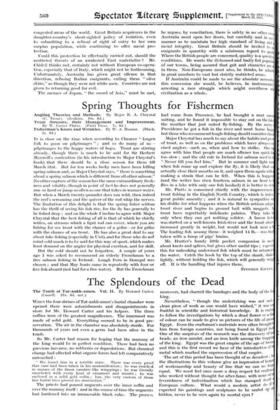The Splendours of the Dead
The Tomb of Tut-ankh-amen. Vol. II. By Howard Carter. (Co-satin. 31s. 6d. net.)
WHEN the four shrines of Tut-ankh-amen's burial chamber were opened there were astonishments and disappointments in store for Mr. howard Carter and his helpers. The three coffins were of the greatest magnificence. The innermost was made of solid gold. Everything seemed to be in good pre- servation. The air in the chamber was absolutely sterile. For thousands of years not even a germ had been alive in the tomb.
So Mr. Carter had reason for hoping that the mummy of the king would be in perfect condition. There had been no previous incourse, no robberies or depredations. But chemical change had affected what organic forces had left comparatively untouched : " We found him in a terrible state. There was every proof that care had been taken in his mummification ; he was swathed in masses of the finest cambric-like wrappings ; he was literally smothered with every kind of ornament and amulet ; he was enclosed in a solid gold coffin ; but, the very custom of those last burial rites proved his destruction."
The priests had poured unguents over the inner coffin and . over the mummy itself : and in the course of time the unguents had hardened into an irremovable black cake. The process moreover, had charred the bandages and the body of the der king.
Nevertheless, " though the undertaking was not such clean piece of work as one would have wished," it was at fruitful in scientific and historical knowledge. It is ezeitti to follow the investigations by which a dead flower or a flay of colour can be made to give us pictures of the life of twee Egypt. Even the craftsman's materials were often brought P him from foreign countries, not being found in Egypt itsri One of the surprises of the research was the discovery of Ir° beads, an iron amulet, and an iron knife among the trapplal of the king. Egypt was the great empire of the age of bro and this is the first record we have of the introduction of metal which marked the supersession of that empire.
The art of this period has been thought of as decadent ; the illustrations to this volume give an impression of honest of workmanship and beauty of line that we can no long equal. We must feel once more a deep respect for craft-sad who worked without thought for after-fame, with none of feverishness of individualism which has stamped itself d European culture. What would a modern artist do if I expected his paintings and scUlptures to be sealed UP fij hidden, never to be seen again by mortal eyes ?






















































 Previous page
Previous page